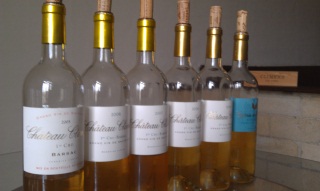2011: The Sauternes Vintage
Post by Alex Shaw | April 6th, 2012

- The "Lord of Barsac"
The sweet wines of Sauternes are undoubtedly wonderful, but they’ve always remained something of a mystery to me. I certainly knew the basics about botrytis (aka “noble rot”), the grape varieties, (primarily Semillon and Sauvignon Blanc, with a bit of Muscadelle at some properties) and of course their great aging potential. They’d always appealed to me, primarily due to the incredible juxtaposition of sweetness and acidity achieved in the greatest Sauternes. But aside from a lone visit to Yquem two years ago, I’d never spent any time in the region or met any of the producers.
It was thus on the last day of our week at en primeurs, when three of my JJ Buckley colleagues and I found ourselves with an entire day to spend in Sauternes and Barsac. We visited eight of the top producers: Doisy Daene, Climens, Yquem, Suduiraut, de Fargues, Rieussec, Coutet and Guiraud. At each stop, we received more insight into soil types, harvest techniques, production methods, and the wines' versatility. We were treated to two meals paired with Sauternes, each highlighting the ways in which these wines can be enjoyed with any course, from starters to dessert, and - surprisingly - everything in between.

- Climens Vineyards
One of the more thought-provoking stops of the day was our second, at Chateau Climens, in Barsac. These wines of Barsac, separated from Sauternes by the Ciron River, tend to show more acidity and minerality thanks to the limestone soil. During harvest, Climens teams of workers harvest small bunches, sometimes even individual berries, that are ripe and show ample boytritis. Teams make multiple passes, or tries, through the vineyard, looking for the best berries. Each day’s harvest is pressed separately and put into its own barrels, so as we wandered through the cellar, it was obvious which day of the harvest each barrel contained.
With 2011 still in barrel, Virginie Achou-Lepage from Climens offered the rare treat of tasting not only directly from the barrels (a first for us during en primeur), but also provided tastes of the harvest from 5 different days. Beginning with September 8 and ending with October 3, we tasted the progression of the harvest, in order to understand how each day's yield would eventually provide something unique from the final blend. The final blend at Climens is a ‘barrel selection’ (as opposed to the Medoc's classic ‘vineyard selection’), so our tasting was akin to sitting at an audio mixing board hearing individual instruments perform solos that will eventually be performed together as a symphony. Certain days' harvests showed more minerality, others more richness; while some brought incredible length, and others contributed structure. It was an amazingly instructive exercise.

- Arriving at the Chateau
It was also a treat, as this was our first and only opportunity to taste the 2011 Climens during en primeur. With the final cuvee not yet blended, Climens declined to provide any samples to negociants or to the UGC Sauternes tasting, a decision I applaud them for. What good would it do to taste a blend that might be different from what goes into the 2011 finished wine? Tasting the individual components gave us a sense of how this wine may ultimately develop, and it certainly makes me look forward to tasting the final 2011 blend.
Following this unforgettable experience, we were treated to a vertical tasting of five vintages of Climens: 2009, 2008, 2007, 2006, and 2005.

- Vertical Tasting at Chateau Climens
Neither I nor any of my colleagues had ever had the opportunity to taste a vertical from an individual Sauternes producer like this, so it was a real learning experience to discover the nuances of each vintage and their evolution during the early stages of development. Some showed notes of white peach and white pineapple, while others revealed rich apricot and mango flavors. Each had varying levels of acidity, while some had prominent notes of salinity or seashells. With 2011 poised to be an excellent vintage for Sauternes, I highly encourage palates of all stripes to take full advantage when these wines hit the market.